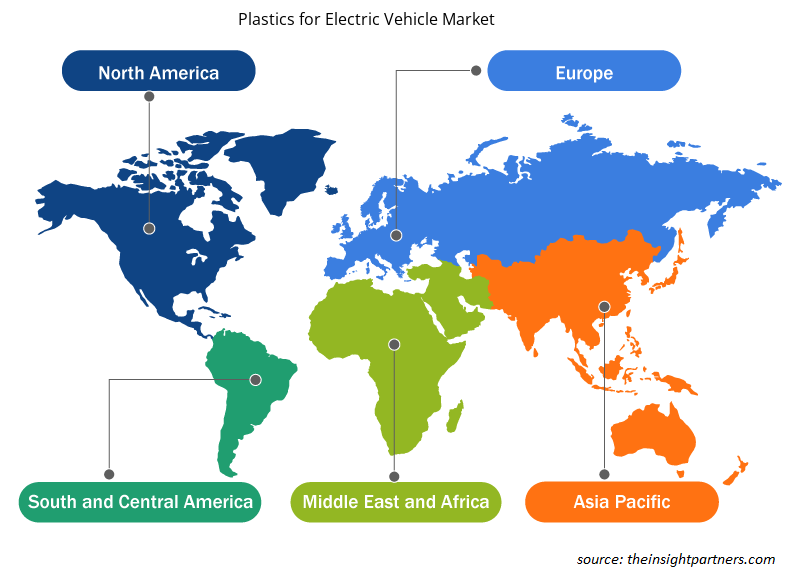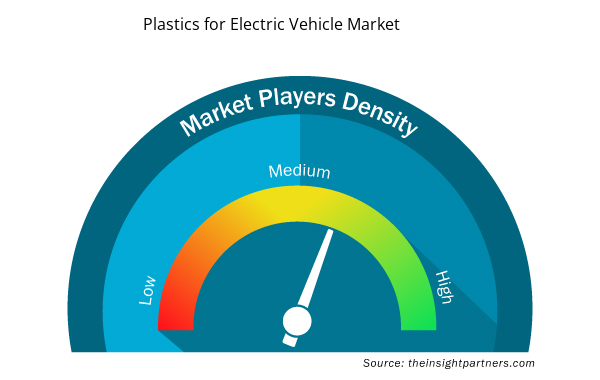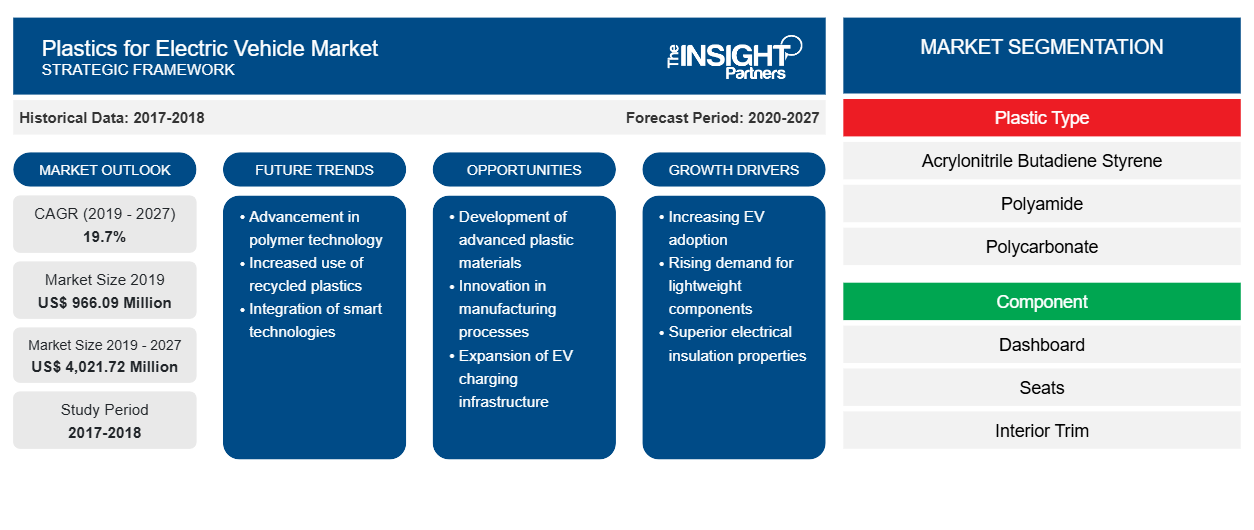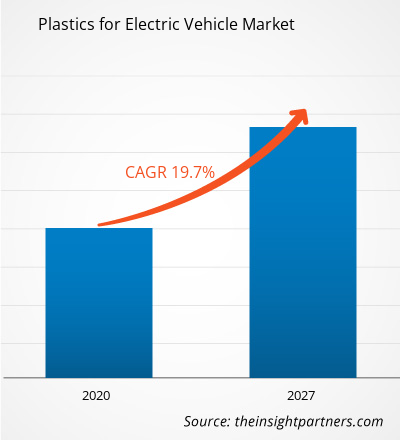El mercado de plástico para vehículos eléctricos se valoró en US$ 966,09 millones en 2019 y se proyecta que alcance los US$ 4.021,72 millones en 2027; se espera que crezca a una CAGR del 19,7% entre 2020 y 2027.
Los plásticos pueden ser conductores eléctricos y también aislantes. Los polímeros termoplásticos se pueden producir en diversas formas y diseños según los requisitos de los vehículos eléctricos debido a la alta versatilidad y la fácil moldeabilidad de los plásticos. El uso de plásticos para vehículos eléctricos reduce el peso de estos vehículos, lo que proporciona una mayor autonomía entre recargas. Los plásticos ofrecen una excelente resistencia al calor que permite la construcción de compartimentos de batería y sistemas de refrigeración y no obstaculizan la durabilidad y la seguridad que brindan los vehículos eléctricos. Se espera que el mercado mundial de plásticos para vehículos eléctricos en América del Norte crezca a la CAGR más alta del 20,0 % durante 2020-2027.
La pandemia de COVID-19 se informó por primera vez en Wuhan (China) en diciembre de 2019. A junio de 2020, Estados Unidos, Rusia, India, España, Brasil, Italia, Francia y Alemania se encuentran entre los países más afectados en términos de casos positivos de COVID-19 y muertes reportadas. El brote está afectando negativamente a las economías e industrias debido a los bloqueos , las prohibiciones de viaje y los cierres de negocios. Los productos químicos y los materiales son una de las principales industrias del mundo que sufre graves interrupciones en forma de interrupciones de la cadena de suministro, cancelaciones de eventos tecnológicos y cierres de oficinas. China es el centro de fabricación mundial y el mayor proveedor de materias primas para varias industrias en todo el mundo, y también es uno de los países más afectados por la pandemia de COVID-19. El cierre de varias plantas y fábricas en China está restringiendo las cadenas de suministro globales y la fabricación y venta de varios productos químicos y materiales. En consecuencia, el impacto general de la pandemia está restringiendo el crecimiento del mercado de plástico para vehículos eléctricos.
Personalice este informe según sus necesidades
Obtendrá personalización en cualquier informe, sin cargo, incluidas partes de este informe o análisis a nivel de país, paquete de datos de Excel, así como también grandes ofertas y descuentos para empresas emergentes y universidades.
- Obtenga las principales tendencias clave del mercado de este informe.Esta muestra GRATUITA incluirá análisis de datos, desde tendencias del mercado hasta estimaciones y pronósticos.
Perspectivas del mercado
La creciente demanda de vehículos eléctricos impulsa el crecimiento del mercado
La fabricación de automóviles está cambiando hacia la generación de menos emisiones de gases de efecto invernadero y hacia una mayor eficiencia en el uso del combustible, con un énfasis creciente en la sostenibilidad ambiental. La relación costo-beneficio, la sostenibilidad ambiental, la conveniencia, la adopción de tecnología avanzada y diversas políticas gubernamentales, como tarifas preferenciales, incentivos para la compra de equipos y descuentos significativos, se encuentran entre los factores que impulsan la demanda de vehículos eléctricos en todo el mundo. Según la AIE , en 2019 se registró un aumento interanual del 40%, con las ventas de 2,1 millones de automóviles eléctricos a nivel mundial, superando significativamente las de 2018.
Información sobre los tipos de plástico
Según el tipo de plástico, el mercado de plásticos para vehículos eléctricos se segmenta en acrilonitrilo butadieno estireno (ABS), poliamida (PA), policarbonato (PC), polivinil butiral, poliuretano (PU), polipropileno (PP) y otros. El segmento de polipropileno (PP) representó la mayor participación del mercado en 2019. El polipropileno (PP) se refiere a un "polímero de adición" termoplástico que se produce mediante la combinación de monómeros de propileno. Es rígido y cristalino; por lo tanto, se usa ampliamente para fabricar objetos como bandejas de embalaje, dispositivos médicos y otros. Como parte de la importante familia de resinas de poliolefina, se moldea y extruye en cualquier tipo de plástico que requiera flexibilidad, tenacidad, ligereza y resistencia al calor.
Información sobre componentes
Según los componentes, el mercado de plástico para vehículos eléctricos se segmenta en tableros, asientos, molduras interiores, tapicería del automóvil, parachoques y otros. El segmento de molduras interiores representó la mayor participación del mercado en 2019. Las molduras interiores de un vehículo eléctrico se refieren a los componentes o paneles de plástico que están presentes dentro de la cabina. Las molduras funcionales y estéticas con características agradables son esenciales para brindar una experiencia interior perfecta.
Información sobre el tipo de vehículo
Según el tipo de vehículo, el mercado de plásticos para vehículos eléctricos se divide en BEV y PHEV/HEV. El segmento BEV representó la mayor participación del mercado en 2019. Los vehículos eléctricos de batería o BEV almacenan electricidad a bordo con paquetes de baterías de alta capacidad. La energía de la batería se utiliza para hacer funcionar el motor eléctrico y otros dispositivos electrónicos a bordo. Los plásticos se utilizan en la fabricación de conectores y carcasas para los componentes eléctricos que se requieren en los vehículos eléctricos.
Información sobre aplicaciones
Según la aplicación, el mercado de plástico para vehículos eléctricos se segmenta además en sistema de tren motriz/bajo el capó, exterior, interior e iluminación y cableado eléctrico. El segmento interior representó la mayor participación del mercado en 2019. Los plásticos de alto rendimiento se utilizan en vehículos eléctricos para brindar seguridad y protección. El polipropileno se utiliza con frecuencia en las piezas de los automóviles, como los bidones de gasolina y las fibras de alfombra del suelo interior. El PVC se utiliza en los tanques y los tableros de instrumentos de los automóviles debido a su acabado elegante. Los volantes y los tableros también se producen con acrilonitrilo butadieno estireno o plásticos ABS. La aplicación a gran escala de plásticos en los volantes, el suelo interior y las consolas favorece el crecimiento del mercado de plásticos para vehículos eléctricos para el segmento de molduras interiores.
Perspectivas regionales sobre el mercado de plásticos para vehículos eléctricos
Los analistas de Insight Partners explicaron en detalle las tendencias y los factores regionales que influyen en el mercado de plásticos para vehículos eléctricos durante el período de pronóstico. Esta sección también analiza los segmentos y la geografía del mercado de plásticos para vehículos eléctricos en América del Norte, Europa, Asia Pacífico, Oriente Medio y África, y América del Sur y Central.

- Obtenga datos regionales específicos para el mercado de plásticos para vehículos eléctricos
Alcance del informe sobre el mercado de plásticos para vehículos eléctricos
| Atributo del informe | Detalles |
|---|---|
| Tamaño del mercado en 2019 | US$ 966,09 millones |
| Tamaño del mercado en 2027 | US$ 4.021,72 millones |
| CAGR global (2019-2027) | 19,7% |
| Datos históricos | 2017-2018 |
| Período de pronóstico | 2020-2027 |
| Segmentos cubiertos | Por tipo de plástico
|
| Regiones y países cubiertos | América del norte
|
| Líderes del mercado y perfiles de empresas clave |
|
Densidad de actores del mercado de plásticos para vehículos eléctricos: comprensión de su impacto en la dinámica empresarial
El mercado de plásticos para vehículos eléctricos está creciendo rápidamente, impulsado por la creciente demanda de los usuarios finales debido a factores como la evolución de las preferencias de los consumidores, los avances tecnológicos y una mayor conciencia de los beneficios del producto. A medida que aumenta la demanda, las empresas amplían sus ofertas, innovan para satisfacer las necesidades de los consumidores y aprovechan las tendencias emergentes, lo que impulsa aún más el crecimiento del mercado.
La densidad de actores del mercado se refiere a la distribución de las empresas o firmas que operan dentro de un mercado o industria en particular. Indica cuántos competidores (actores del mercado) están presentes en un espacio de mercado determinado en relación con su tamaño o valor total de mercado.
Las principales empresas que operan en el mercado de plásticos para vehículos eléctricos son:
- BASF SE
- Solvay SA
- DuPont de Nemours, Inc.
- La compañía química Dow
- LG Chem Ltd
Descargo de responsabilidad : Las empresas enumeradas anteriormente no están clasificadas en ningún orden particular.

- Obtenga una descripción general de los principales actores clave del mercado de plásticos para vehículos eléctricos
Informe Destacado
- Tendencias progresivas de la industria en el mercado mundial de plásticos para vehículos eléctricos que ayudan a los actores a desarrollar estrategias efectivas a largo plazo
- Estrategias de crecimiento empresarial adoptadas por los mercados desarrollados y en desarrollo
- Análisis cuantitativo del mercado de plásticos para vehículos eléctricos de 2017 a 2027
- Estimación de la demanda de plástico para vehículos eléctricos en diversas industrias a nivel mundial
- Análisis PEST para ilustrar la eficacia de los compradores y proveedores que operan en el mercado
- Desarrollos recientes para comprender el escenario competitivo del mercado y la demanda de plástico para vehículos eléctricos
- Tendencias y perspectivas del mercado y factores que impulsan y restringen el crecimiento del mercado
- Comprensión de las estrategias que sustentan el crecimiento del mercado mundial de plástico para vehículos eléctricos, lo que ayuda a las partes interesadas en la toma de decisiones.
- Tamaño del mercado de plástico para vehículos eléctricos en varios nodos del mercado
- Descripción detallada y segmentación del mercado y dinámica de la industria.
- Tamaño del mercado mundial de plástico para vehículos eléctricos en varias regiones con oportunidades de crecimiento prometedoras en estas regiones
Mercado de plásticos para vehículos eléctricos, por tipo de plástico
- Acrilonitrilo butadieno estireno
- Poliamida
- Policarbonato
- Butiral de polivinilo
- Poliuretano
- Polipropileno
- Otros
Mercado de plásticos para vehículos eléctricos, por componente
- Panel
- Asientos
- Acabado interior
- Tapicería de automóviles
- Parachoques
- Otros
Mercado de plásticos para vehículos eléctricos, por tipo de vehículo
- VEB
- Vehículos híbridos enchufables (PHEV) y vehículos híbridos eléctricos (HEV)
Mercado de plásticos para vehículos eléctricos, por aplicación
- Sistema de tren motriz/debajo del capó
- Exterior
- Interior
- Iluminación y cableado eléctrico
Perfiles de empresas
- BASF SE
- Solvay SA
- DuPont de Nemours, Inc.
- La compañía química Dow
- Compañía química LG Ltd.
- Lanxess AG
- Sabic
- Covestro AG
- Corporación Asahi Kasei
- Lyondellbasell Industries Holdings BV
- Análisis histórico (2 años), año base, pronóstico (7 años) con CAGR
- Análisis PEST y FODA
- Tamaño del mercado Valor/volumen: global, regional, nacional
- Industria y panorama competitivo
- Conjunto de datos de Excel



Report Coverage
Revenue forecast, Company Analysis, Industry landscape, Growth factors, and Trends

Segment Covered
This text is related
to segments covered.

Regional Scope
North America, Europe, Asia Pacific, Middle East & Africa, South & Central America

Country Scope
This text is related
to country scope.
Preguntas frecuentes
In 2019, Asia Pacific held the largest share of the global plastics for electric vehicles market. The demand for plastics for electric vehicles is expected to increase in the region with the increase in the educated population who demand for more and more electric vehicles. The rise in disposable income and per capita consumption supports the market growth. The rising production capacities of the manufacturers of plastics favors the growth of plastics for electric vehicles market in the region. Continuous innovations in the application of plastics for electric vehicles is yet another factor driving the demand for plastics for electric vehicles. Besides these, rising awareness about the benefits of electric vehicles and initiatives taken by the Government for supporting the demand for plastics for electric vehicles, provides lucrative opportunity for the development of plastics for electric vehicles market in Asia Pacific.
The growth of polyurethane segment is primarily attributed to the fact that polyurethane (PU) is considered to be one of the most versatile plastic materials. It is formed by the reaction of polyol along with a di- isocyanate or a polymeric isocyanate in the presence of an additive or a catalyst. Polyurethane structure comprises of three complex monomers namely, diisocyanate, a macrodial and chain extender, on the basis of which many polyurethane materials can be synthesized. The polyurethane polymers are also characterized by the presence of urethane linkage. Depending on the length and nature of the hydroxyl and isocyanate molecule, the thermoplastic, hard, soft, flexible and cellular type of polyurethane is synthesized. The resultant structure resembles that of polyamide as both of them comprises of CONH groups. Polyurethane possess versatile properties like toughness, biocompatibility and durability that can be tailored depending on the application. In electronic vehicles, the engineers prefer using thermoset polyurethane adhesives for the purpose of bonding the dissimilar materials to the frame of cars. These adhesives are strong and helps in reducing the need for heavy and bulky bolts & rivets. They also help in keeping down the weight of the vehicle curb thus making the cars light & fast along with excellent charge range. Polyurethane is also used in shock absorption components in vehicles. The automakers also prefer using cast polyurethane in muffler systems. It is extensively used in electric vehicle car batteries and provide smoothest driving experience. All these factors are responsible for polyurethane segment to grow at the high rate.
The major players operating in the global plastics for electrical vehicle market are BASF SE, Solvay S.A., DuPont de Nemours, Inc., The Dow Chemical Company, LG Chem Ltd, Lanxess AG, Sabic, Covestro AG, Asahi Kasei Corporation and LyondellBasell Industries Holdings B.V.
Trends and growth analysis reports related to Chemicals and Materials : READ MORE..
The List of Companies - Global Plastics for Electric Vehicle Market
- BASF SE
- Solvay S.A.
- DuPont de Nemours, Inc.
- The Dow Chemical Company
- LG Chem Ltd
- Lanxess AG
- Sabic
- Covestro AG
- Asahi Kasei Corporation
- LyondellBasell Industries Holdings B.V
The Insight Partners performs research in 4 major stages: Data Collection & Secondary Research, Primary Research, Data Analysis and Data Triangulation & Final Review.
- Data Collection and Secondary Research:
As a market research and consulting firm operating from a decade, we have published and advised several client across the globe. First step for any study will start with an assessment of currently available data and insights from existing reports. Further, historical and current market information is collected from Investor Presentations, Annual Reports, SEC Filings, etc., and other information related to company’s performance and market positioning are gathered from Paid Databases (Factiva, Hoovers, and Reuters) and various other publications available in public domain.
Several associations trade associates, technical forums, institutes, societies and organization are accessed to gain technical as well as market related insights through their publications such as research papers, blogs and press releases related to the studies are referred to get cues about the market. Further, white papers, journals, magazines, and other news articles published in last 3 years are scrutinized and analyzed to understand the current market trends.
- Primary Research:
The primarily interview analysis comprise of data obtained from industry participants interview and answers to survey questions gathered by in-house primary team.
For primary research, interviews are conducted with industry experts/CEOs/Marketing Managers/VPs/Subject Matter Experts from both demand and supply side to get a 360-degree view of the market. The primary team conducts several interviews based on the complexity of the markets to understand the various market trends and dynamics which makes research more credible and precise.
A typical research interview fulfils the following functions:
- Provides first-hand information on the market size, market trends, growth trends, competitive landscape, and outlook
- Validates and strengthens in-house secondary research findings
- Develops the analysis team’s expertise and market understanding
Primary research involves email interactions and telephone interviews for each market, category, segment, and sub-segment across geographies. The participants who typically take part in such a process include, but are not limited to:
- Industry participants: VPs, business development managers, market intelligence managers and national sales managers
- Outside experts: Valuation experts, research analysts and key opinion leaders specializing in the electronics and semiconductor industry.
Below is the breakup of our primary respondents by company, designation, and region:

Once we receive the confirmation from primary research sources or primary respondents, we finalize the base year market estimation and forecast the data as per the macroeconomic and microeconomic factors assessed during data collection.
- Data Analysis:
Once data is validated through both secondary as well as primary respondents, we finalize the market estimations by hypothesis formulation and factor analysis at regional and country level.
- Macro-Economic Factor Analysis:
We analyse macroeconomic indicators such the gross domestic product (GDP), increase in the demand for goods and services across industries, technological advancement, regional economic growth, governmental policies, the influence of COVID-19, PEST analysis, and other aspects. This analysis aids in setting benchmarks for various nations/regions and approximating market splits. Additionally, the general trend of the aforementioned components aid in determining the market's development possibilities.
- Country Level Data:
Various factors that are especially aligned to the country are taken into account to determine the market size for a certain area and country, including the presence of vendors, such as headquarters and offices, the country's GDP, demand patterns, and industry growth. To comprehend the market dynamics for the nation, a number of growth variables, inhibitors, application areas, and current market trends are researched. The aforementioned elements aid in determining the country's overall market's growth potential.
- Company Profile:
The “Table of Contents” is formulated by listing and analyzing more than 25 - 30 companies operating in the market ecosystem across geographies. However, we profile only 10 companies as a standard practice in our syndicate reports. These 10 companies comprise leading, emerging, and regional players. Nonetheless, our analysis is not restricted to the 10 listed companies, we also analyze other companies present in the market to develop a holistic view and understand the prevailing trends. The “Company Profiles” section in the report covers key facts, business description, products & services, financial information, SWOT analysis, and key developments. The financial information presented is extracted from the annual reports and official documents of the publicly listed companies. Upon collecting the information for the sections of respective companies, we verify them via various primary sources and then compile the data in respective company profiles. The company level information helps us in deriving the base number as well as in forecasting the market size.
- Developing Base Number:
Aggregation of sales statistics (2020-2022) and macro-economic factor, and other secondary and primary research insights are utilized to arrive at base number and related market shares for 2022. The data gaps are identified in this step and relevant market data is analyzed, collected from paid primary interviews or databases. On finalizing the base year market size, forecasts are developed on the basis of macro-economic, industry and market growth factors and company level analysis.
- Data Triangulation and Final Review:
The market findings and base year market size calculations are validated from supply as well as demand side. Demand side validations are based on macro-economic factor analysis and benchmarks for respective regions and countries. In case of supply side validations, revenues of major companies are estimated (in case not available) based on industry benchmark, approximate number of employees, product portfolio, and primary interviews revenues are gathered. Further revenue from target product/service segment is assessed to avoid overshooting of market statistics. In case of heavy deviations between supply and demand side values, all thes steps are repeated to achieve synchronization.
We follow an iterative model, wherein we share our research findings with Subject Matter Experts (SME’s) and Key Opinion Leaders (KOLs) until consensus view of the market is not formulated – this model negates any drastic deviation in the opinions of experts. Only validated and universally acceptable research findings are quoted in our reports.
We have important check points that we use to validate our research findings – which we call – data triangulation, where we validate the information, we generate from secondary sources with primary interviews and then we re-validate with our internal data bases and Subject matter experts. This comprehensive model enables us to deliver high quality, reliable data in shortest possible time.


 Obtenga una muestra gratuita de este informe
Obtenga una muestra gratuita de este informe